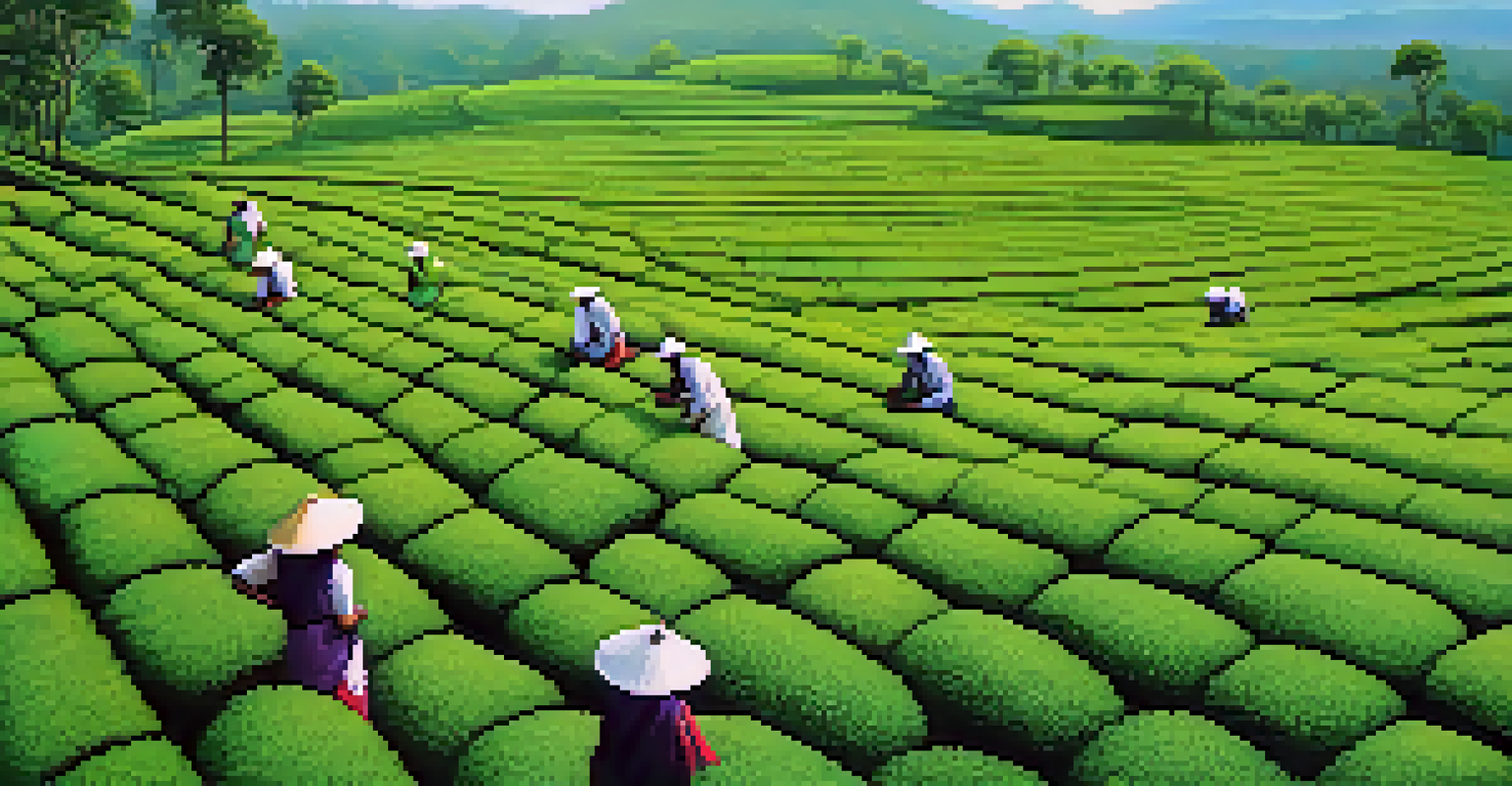Exploring India’s Scenic Tea Plantations: A Traveler’s Guide

An Introduction to India’s Tea Plantations and Their Beauty
India is renowned for its lush tea plantations, each offering a unique glimpse into the country's rich agricultural heritage. From the misty hills of Darjeeling to the sprawling estates of Assam, these plantations are not just farms; they are scenic landscapes that captivate travelers. Imagine walking through rows of vibrant green tea bushes, surrounded by the fragrance of fresh leaves and the sound of rustling wind.
Tea is the magic elixir that transforms the ordinary into the extraordinary.
The tea plantations are often set against stunning backdrops, whether it’s the Himalayan foothills or the rolling hills of the Western Ghats. Each region boasts distinct flavors and varieties of tea, making them a haven for tea lovers. However, they also provide a slice of tranquility for those seeking to escape the hustle and bustle of city life.
Visiting these plantations is more than just a visual treat; it's an opportunity to learn about the entire tea-making process, from plucking leaves to brewing a perfect cup. So, pack your bags and get ready for an adventure that tantalizes the senses!
Top Regions to Explore India’s Scenic Tea Plantations
India has several key regions famous for their tea plantations, each with its own charm and characteristics. Darjeeling, often referred to as the 'Champagne of Teas,' is known for its exquisite flavors and breathtaking views of the Himalayas. The tea estates here are often perched on steep hillsides, offering visitors a panoramic view that is simply unforgettable.

Assam, on the other hand, is known for its robust and malty teas, with sprawling plantations that stretch as far as the eye can see. The lush greenery and the warm hospitality of the locals make it a delightful destination for tea enthusiasts. Don't forget to explore the nearby wildlife sanctuaries, where you might spot an elephant or two!
Explore India's Scenic Tea Regions
India's diverse tea regions, from Darjeeling to Assam, offer unique flavors and breathtaking landscapes that delight tea lovers.
Then there's Munnar in Kerala, famous for its rolling hills and cool climate, making it perfect for tea cultivation. The picturesque landscapes are a photographer’s dream, and the blend of tea gardens with waterfalls creates an enchanting scene. Each of these regions offers a unique experience, making them must-visit spots when exploring India’s tea culture.
Best Time to Visit Tea Plantations in India
Timing your visit to India’s tea plantations can greatly enhance your experience. Generally, the best time to visit is during the cooler months, from October to March. This period offers clear skies, pleasant temperatures, and the chance to witness the tea harvest, where workers skillfully pluck the tender leaves.
Where there’s tea there’s hope.
In Darjeeling, the spring months of March to May are particularly beautiful, as the tea bushes burst with new growth and the flowers bloom. You can also enjoy the annual tea festivals during this time, where you can immerse yourself in local culture and traditions. Imagine sipping fresh tea while enjoying traditional music and dance!
Meanwhile, visiting Assam during the monsoon season can be a unique experience, though it comes with the risk of heavy rainfall. The vibrant green hues of the plantations are intensified, and the atmosphere is refreshingly cool. However, it’s essential to check weather conditions and plan accordingly to make the most of your trip.
Activities to Enjoy in Tea Plantations
Tea plantations offer a variety of activities that go beyond just sipping tea. Guided tours allow you to explore the estates, where knowledgeable guides share insights about the history and cultivation of tea. You can also participate in tea tasting sessions, where you can learn to differentiate flavors and aromas – it’s a delightful experience for your taste buds.
For the adventurous at heart, some plantations offer treks through the hills. These treks not only provide an up-close view of the tea bushes but also lead you to stunning viewpoints where you can soak in the beauty of the landscape. Imagine hiking through misty trails, with the aroma of fresh tea leaves filling the air!
Engage in Cultural Experiences
Visiting tea plantations provides opportunities to immerse yourself in local culture through music, dance, and traditional tea-making.
Lastly, don’t miss the chance to interact with the local tea workers. Their stories and experiences add a rich layer to your understanding of tea production. You might even get a chance to learn how to brew the perfect cup of chai – a skill that will surely impress your friends back home!
Cultural Experiences in Tea Plantations
Visiting tea plantations in India also opens the door to rich cultural experiences. Many estates host cultural events where visitors can enjoy local music, dance, and cuisine. This is a wonderful opportunity to immerse yourself in the local traditions and connect with the community.
You might find that some plantations offer workshops on traditional tea-making techniques. Here, you can learn how to brew different types of tea, from black to green, and even try your hand at making masala chai, a popular Indian spiced tea. These hands-on experiences are not only fun but also deepen your appreciation for this beloved beverage.
Additionally, exploring the nearby villages can provide insights into the lives of those who work on the plantations. Their stories often highlight the deep connection between the land and the people, making your visit all the more meaningful. Engaging with locals can transform your trip into a journey of discovery and understanding.
Where to Stay Near Tea Plantations
When planning your trip to India’s tea plantations, finding the right place to stay can enhance your experience. Many tea estates offer charming accommodations right on the plantation grounds, allowing you to wake up surrounded by the serene beauty of tea gardens. Imagine sipping your morning tea while overlooking the lush landscape!
In addition to estate stays, there are also boutique hotels and homestays available nearby. These options can provide a cozy atmosphere and personalized service while giving you a taste of local hospitality. Staying in a homestay allows you to experience daily life in the region, including home-cooked meals made from fresh, local ingredients.
Best Times to Visit Tea Plantations
The ideal time to visit India's tea plantations is from October to March, when the weather is pleasant and tea harvesting occurs.
For those who prefer modern amenities, there are luxury resorts and eco-friendly lodges that cater to every need. These accommodations often feature spa services, gourmet dining, and guided tours, ensuring a comfortable and enriching stay. Regardless of your choice, the stunning views and tranquil environment are sure to leave a lasting impression.
Essential Tips for Visiting India’s Tea Plantations
Before you embark on your journey to India’s tea plantations, there are a few essential tips to keep in mind. First and foremost, pack comfortable clothing and sturdy shoes, especially if you plan to explore on foot. The terrain can be uneven, and you’ll want to be prepared for spontaneous hikes or strolls through the gardens.
It’s also wise to carry a reusable water bottle to stay hydrated, especially during warmer months. Many plantations are eco-conscious and encourage visitors to minimize plastic waste. Plus, you’ll want to sample plenty of fresh tea – and staying hydrated is key to fully enjoying the experience!

Lastly, be respectful of local customs and practices. Engaging with the community, asking questions, and showing appreciation for their work can lead to meaningful interactions. Remember, travel is as much about the journey and connections you make as it is about the destinations you visit.